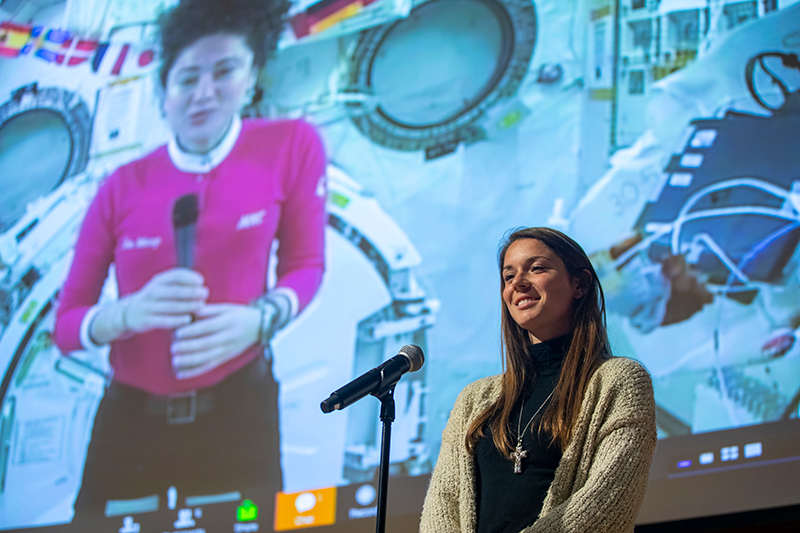PROVIDENCE, R.I. [Brown University] — Just a few years ago, Jessica Meir nearly let go of her lifelong dream to fly in space.
She had been chosen as a finalist for the 2009 class of NASA astronauts, but ultimately was not selected as one of the nine women and men in that class. When it came time to apply for the 2013 class, she wasn’t sure she wanted to go through it all again.
“I was working as a comparative physiologist, doing experiments with animals in extreme environments, and it was something I felt [was] very fulfilling,” said Meir, a Class of 1999 Brown graduate. “When the time came to apply again I thought, well, do I want to put myself through that mental toll and long process when I'm sure it will be the same result?”
In the end, Meir decided that not applying would be a decision she’d question for the rest of her life. So she did apply, and on Sept. 25, 2019, she lifted off for her first mission in space as a crew member on the International Space Station.
On Thursday, Feb. 13, Meir shared a message of perseverance with hundreds of Brown students and community members gathered on campus for a live Q&A session streamed from the ISS as Meir flew 250 miles above the Earth. The event was held as part of Brown's yearlong, community-wide celebration and exploration of the 50th anniversary of the Open Curriculum, the University’s innovative approach to teaching and learning.
“It was a decision I had to make to do that — to take the risk and not be afraid to fail again,” she said. “And because I did that, that's really the only reason why I ended up here today. If you don't try, then of course it's not going to happen.”
During 30 minutes of questions and answers, Meir discussed the future of human spaceflight, the challenges involved in becoming an astronaut and how she and her fellow astronauts stay physically and mentally healthy in space.
Having recently completed the first all-woman spacewalk in history with crewmate Christina Koch, Meir was asked her thoughts on the importance of diversity and inclusion in the space program. She said that there is a great need to make the space program “a reflection of our society, a reflection of all human kind.” She added that the all-woman spacewalk last October was a recognition that “it is no longer okay to [explore space] if there is just a few people being represented.”
Bella Carlos, an undergraduate concentrating in anthropology at Brown and illustration at the Rhode Island School of Design through the schools' dual degree program, wanted to know what was the most visually surprising thing about the Earth that Meir has noticed from her orbital perspective.
“I remember one of my first impressions was how the atmosphere looked,” Meir said. “First of all, the most remarkable thing is how thin it is, and it makes you realize how important it is that we protect it. But then you can actually see... a gradient of different blues. You can see how the air is getting thinner and thinner with altitude until it fades out into the blackness of space.”
Calder Smith-Montross, a sixth-grader at Gordon School in Providence, wanted to know how weightlessness affects astronauts' veins and arteries. Meir explained that while scientists have some ideas on the subject, no one is exactly sure what those effects might be. She and her team are currently leading experiments to help answer that question.
“That is exactly why we're doing experiments to try to understand that process more,” Meir said. “We do need to figure out why these things are happening and how we might prevent them if we're having deleterious consequences to our health.”
Meir said that her time at Brown was important in her progression from self-described “space geek” to NASA astronaut. As an undergraduate, she got involved in a summer program studying aspects of space biology. She and a few other students also designed an experiment that was carried out as part of NASA’s Reduced Gravity Student Flight Opportunities Program, which involved the aircraft affectionately known as the “vomit comet.”

She also had a chance to interact with Jim Head, a geology professor who has worked extensively with NASA for decades. Head, who gave introductory remarks at Thursday's event, was involved with the Apollo missions to the Moon, helping to train astronauts, select landing sites and analyze returned lunar samples. He continues to work with NASA’s astronaut training program, including Meir’s 2013 class. For years, Head taught a class focusing on the comparative geology of the Earth, Moon and Mars.
“Even though I majored in biology, I really wanted to take Professor Head's geology course,” Meir said. “That started the friendship and colleagueship that I have with Professor Head... even into our astronaut candidate training program.”
With her travel to the International Space Station, Meir adds her name to a long list of Brown faculty, students and alumni who have played major roles in space exploration. Head and several other Brown faculty members continue to play key roles in numerous NASA missions, including the Curiosity rover currently on Mars and the Mars 2020 rover that will launch later this year. Two Brown Ph.D. graduates have recently served as NASA’s chief scientist — James Garvin from 2004 to 2005 and Ellen Stofan from 2013 to 2016. Stofan is currently director of the Smithsonian National Air and Space Museum.
Ashley Palumbo, a Ph.D. student in planetary geology at Brown and an aspiring astronaut herself, said she was thrilled and encouraged to see a fellow Brunonian flying in space. She expects that other aspiring astronauts in the crowd felt the same.
“It makes it all very real for us,” Palumbo said.